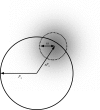Recent developments in classical density modification
- PMID: 20383000
- PMCID: PMC2852311
- DOI: 10.1107/S090744490903947X
Recent developments in classical density modification
Abstract
Classical density-modification techniques (as opposed to statistical approaches) offer a computationally cheap method for improving phase estimates in order to provide a good electron-density map for model building. The rise of statistical methods has lead to a shift in focus away from the classical approaches; as a result, some recent developments have not made their way into classical density-modification software. This paper describes the application of some recent techniques, including most importantly the use of prior phase information in the likelihood estimation of phase errors within a classical density-modification framework. The resulting software gives significantly better results than comparable classical methods, while remaining nearly two orders of magnitude faster than statistical methods.
Figures


Similar articles
-
Automated structure solution, density modification and model building.Acta Crystallogr D Biol Crystallogr. 2002 Nov;58(Pt 11):1937-40. doi: 10.1107/s0907444902016438. Epub 2002 Oct 21. Acta Crystallogr D Biol Crystallogr. 2002. PMID: 12393925
-
Statistical density modification using local pattern matching.Acta Crystallogr D Biol Crystallogr. 2003 Oct;59(Pt 10):1688-701. doi: 10.1107/s0907444903015142. Epub 2003 Sep 19. Acta Crystallogr D Biol Crystallogr. 2003. PMID: 14501107 Free PMC article.
-
Reciprocal-space solvent flattening.Acta Crystallogr D Biol Crystallogr. 1999 Nov;55(Pt 11):1863-71. doi: 10.1107/s0907444999010033. Acta Crystallogr D Biol Crystallogr. 1999. PMID: 10531484 Free PMC article.
-
Error estimation and bias correction in phase-improvement calculations.Acta Crystallogr D Biol Crystallogr. 1999 Sep;55(Pt 9):1555-67. doi: 10.1107/s0907444999007416. Acta Crystallogr D Biol Crystallogr. 1999. PMID: 10489450 Review.
-
EDM-DEDM and protein crystal structure solution.Acta Crystallogr D Biol Crystallogr. 2009 May;65(Pt 5):477-84. doi: 10.1107/S0907444909008609. Epub 2009 Apr 18. Acta Crystallogr D Biol Crystallogr. 2009. PMID: 19390153 Review.
Cited by
-
A novel family of soluble minimal scaffolds provides structural insight into the catalytic domains of integral membrane metallopeptidases.J Biol Chem. 2013 Jul 19;288(29):21279-21294. doi: 10.1074/jbc.M113.476580. Epub 2013 Jun 3. J Biol Chem. 2013. PMID: 23733187 Free PMC article.
-
Structural characterization and oligomerization of the TssL protein, a component shared by bacterial type VI and type IVb secretion systems.J Biol Chem. 2012 Apr 20;287(17):14157-68. doi: 10.1074/jbc.M111.338731. Epub 2012 Feb 27. J Biol Chem. 2012. PMID: 22371492 Free PMC article.
-
Solving protein structures by combining structure prediction, molecular replacement and direct-methods-aided model completion.IUCrJ. 2024 Mar 1;11(Pt 2):152-167. doi: 10.1107/S2052252523010291. IUCrJ. 2024. PMID: 38214490 Free PMC article.
-
Expression, purification and preliminary structural analysis of the coiled-coil domain of Deinococcus radiodurans RecN.Acta Crystallogr Sect F Struct Biol Cryst Commun. 2012 Feb 1;68(Pt 2):218-21. doi: 10.1107/S1744309111055187. Epub 2012 Jan 26. Acta Crystallogr Sect F Struct Biol Cryst Commun. 2012. PMID: 22298004 Free PMC article.
-
The Human Mixed Lineage Leukemia 5 (MLL5), a Sequentially and Structurally Divergent SET Domain-Containing Protein with No Intrinsic Catalytic Activity.PLoS One. 2016 Nov 3;11(11):e0165139. doi: 10.1371/journal.pone.0165139. eCollection 2016. PLoS One. 2016. PMID: 27812132 Free PMC article.
References
-
- Abrahams, J. P. (1997). Acta Cryst. D53, 371–376. - PubMed
-
- Abrahams, J. P. & Leslie, A. G. W. (1996). Acta Cryst. D52, 30–42. - PubMed
-
- Brünger, A. T., Adams, P. D., Clore, G. M., DeLano, W. L., Gros, P., Grosse-Kunstleve, R. W., Jiang, J.-S., Kuszewski, J., Nilges, M., Pannu, N. S., Read, R. J., Rice, L. M., Simonson, T. & Warren, G. L. (1998). Acta Cryst. D54, 905–921. - PubMed
-
- Caliandro, R., Carrozzini, B., Cascarano, G. L., De Caro, L., Giacovazzo, C. & Siliqi, D. (2005). Acta Cryst. D61, 556–565. - PubMed
-
- Cowtan, K. (1999). Acta Cryst. D55, 1555–1567. - PubMed
Publication types
MeSH terms
Grants and funding
LinkOut - more resources
Full Text Sources
Other Literature Sources

